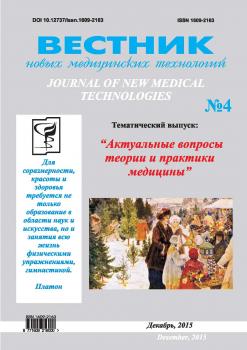Fossil bacteria are evolutionarily valuable forms of life. In permafrost conditions for a very long time, bacteria can develop a unique repair mechanisms of structural and functional defects. In the experiment on mice of BALB/c it was revealed the presence of high reparative capacity in fossil bacteria strain MG8 Bacillus sp., isolated from samples of relict permafrost, and their metabolic products – metabolites that can be delegated to other living systems. Ability to regulate reparative processes in macroorganism shows in MG8 in the doses less than 20×1103 microbial cells and topically on the wound surface. The “thermal" metabolites, produced by culturing the bacteria at 37°C, are leaders modulation of repair processes in healing skin blemishes. Local application on the wound ointment with "heat" metabolites allows to accelerate by 30% the process of reparation relative to placebo, by 20% – relative to the medicinal product "Solcoseryl" and by 10% – faster than under the influence of bacteria. Dynamics of morphogenetic processes in the healing of skin defect under MG8 bacteria effect and their metabolites is correlated with the dynamics of immune system activity. The sequence of changes in the activity of various components of the immune system (cellular factors inherent immunoresistance – cell immunity humoral immunity) corresponds to the stage of development of the repair process (damage – inflammation – recovery). Mechanisms of regulation of repair processes in the immune system consistent with the general laws regulating the inflammatory process and changes in waves: the predominant increase in the activity of pro-inflammatory mechanisms replaced predominant anti-inflammatory mechanisms of increased activity of the immune system. Using strain MG8 metabolites allows to optimize regenerative process, to reduce time of wound contraction and the formation of scar tissue, to full restore of the coat, so they can be modulators of the wound process, with a predominance of regeneration mechanisms
microorganisms from permafrost, skin wounds, repair, repair rate, reactivity of the immune system
1. Belova O.V., Arion V.Ya. Immunologicheskaya funktsiya kozhi i neyroimmunokozhnaya sistema. Allergologiya i immunologiya. 2006. T. 7. № 4. S. 492-497.
2. Brushkov A.V., Mel´nikov V.P., Shchelchkova V.P., Griva G.I., Repin V.E., Brenner E.V., Tanaka E.V. Bio-geokhimiya merzlykh porod Tsentral´noy Yakutii. Kriosfera Zemli. 2011. T. XY. № 4. S. 90-100.
3. Katunina O.R., Rezaykina A.V. Sovremennye predstavleniya ob uchastii kozhi v immunnykh protsessakh. Vestn. dermatol. i venerol. 2009. № 2. S. 39-46.
4. Tukhbatova R.I., Abdel´rakhman A.A., Mukhamet-zyanova A.S., Nguen T.T., Khoang T.T., Fattakhova A.N., Alimova F.K. Vliyanie metabolitov Trichoderma asperellum na regeneratsiyu tkaney na fone pirena. Kletochnaya transplantologiya i tkanevaya inzheneriya. 2012. T. VII. № 3. S. 159-163.
5. Shul´ga E.A., Grozesku E.A., Bakhareva A.A. Le-chebnye svoystva probiotika «Subtilis» pri reparatsii kozhnykh pokrovov osetrovykh ryb. Vestnik AGTU. Seriya: Rybnoe khozyaystvo. 2009. №1. C. 86-89.
6. Barrientos S., Stojadinovic O., Golinko M.S., Brem H., Tomic-Canic M. Growth factors and cytokines in wound healing. Wound Repair Regen. 2008. Vol. 16. № 5. P. 585-601.
7. Brancato S.K., Albina J.E. Wound macrophages as key regulators of repair: origin, phenotype, and function. Am. J. Pathol. 2011. Vol. 178. № 1. P. 19-25.
8. Wilgus T.A. Immune cells in the healing skin wound: influential players at each stage of repair. Pharmacol. Res. 2008. Vol. 58. № 2. P. 112-116.
9. Gurtner G.C., Werner S., Barrandon Y., Longak-er M.T. Wound repair and regeneration. Nature. 2008. Vol. 453. № 7193. P. 314-321.
10. Kalenova L.F., Suhovey U.G., Broushkov A.V., Melnikov V.P., Fisher T.A., Besedin I.M., Novikova M.A., Efimova J.A., Subbotin A.M. Experimental study of the effects of permafrost microorganisms on the morphofunctional activity of the immune system. Bulletin of Experimental Biology and Medicine. 2011. Vol. 151. № 2. P. 201-204.
11. Kalenova L.F., Suhovey U.G., Broushkov A.V., Melnikov V.P., Fisher T.A., Besedin I.M., Novikova M.A., Efimova J.A. Effects of permafrost microorganisms on the quality and duration of life of laboratory animals. Neuroscience and Behavioral Physiology. 2011. Vol. 41. № 5. P. 484-490.
12. Lucas T., Waisman A., Ranjan R., Roes J., Krieg T., Mtiller W., Roers A., Eming SA. Differential roles of macrophages in diverse phases of skin repair. J Immu-nol. 2010. Vol. 184. № 7. C. 3964-3977.
13. Mahdavian Delavary B., van der Veer W.M., van Egmond M., Niessen F.B., Beelen R.H. Macrophages in skin injury and repair. Immunobiology. 2011. Vol. 216. № 7. P. 753-762.
14. Park J.E., Barbul A. Understanding the role of immune regulation in wound healing. Am J. Surg. 2004. № 187. R. 11-16.
15. Rodero M.P., Khosrotehrani K. Skin wound healing modulation by macrophages. Tnt. J. Clin. Exp. Pathol. 2010. Vol. 3. № 7. C. 643-653.
16. Sato T., Yamamoto M., Shimosato T., Klinman D.M. Accelerated wound healing mediated by activa-tion of Toll-like receptor 9. Wound Repair Regen. 2010. Vol. 18. № 6. P. 586-593.





